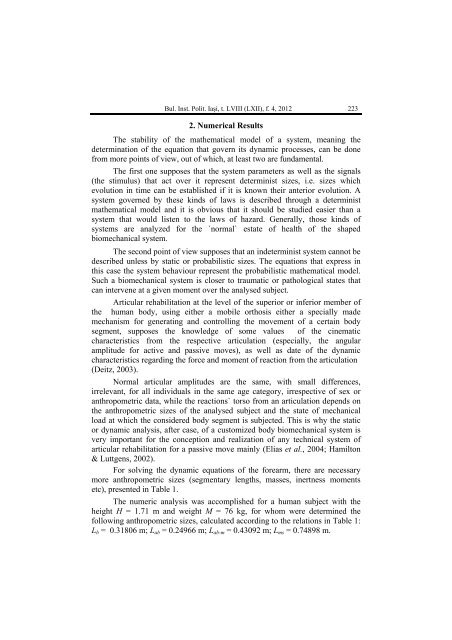buletinul institutului politehnic din iaşi - Universitatea Tehnică ...
buletinul institutului politehnic din iaşi - Universitatea Tehnică ...
buletinul institutului politehnic din iaşi - Universitatea Tehnică ...
Create successful ePaper yourself
Turn your PDF publications into a flip-book with our unique Google optimized e-Paper software.
Bul. Inst. Polit. Iaşi, t. LVIII (LXII), f. 4, 2012 223<br />
2. Numerical Results<br />
The stability of the mathematical model of a system, meaning the<br />
determination of the equation that govern its dynamic processes, can be done<br />
from more points of view, out of which, at least two are fundamental.<br />
The first one supposes that the system parameters as well as the signals<br />
(the stimulus) that act over it represent determinist sizes, i.e. sizes which<br />
evolution in time can be established if it is known their anterior evolution. A<br />
system governed by these kinds of laws is described through a determinist<br />
mathematical model and it is obvious that it should be studied easier than a<br />
system that would listen to the laws of hazard. Generally, those kinds of<br />
systems are analyzed for the `normal` estate of health of the shaped<br />
biomechanical system.<br />
The second point of view supposes that an indeterminist system cannot be<br />
described unless by static or probabilistic sizes. The equations that express in<br />
this case the system behaviour represent the probabilistic mathematical model.<br />
Such a biomechanical system is closer to traumatic or pathological states that<br />
can intervene at a given moment over the analysed subject.<br />
Articular rehabilitation at the level of the superior or inferior member of<br />
the human body, using either a mobile orthosis either a specially made<br />
mechanism for generating and controlling the movement of a certain body<br />
segment, supposes the knowledge of some values of the cinematic<br />
characteristics from the respective articulation (especially, the angular<br />
amplitude for active and passive moves), as well as date of the dynamic<br />
characteristics regar<strong>din</strong>g the force and moment of reaction from the articulation<br />
(Deitz, 2003).<br />
Normal articular amplitudes are the same, with small differences,<br />
irrelevant, for all individuals in the same age category, irrespective of sex or<br />
anthropometric data, while the reactions` torso from an articulation depends on<br />
the anthropometric sizes of the analysed subject and the state of mechanical<br />
load at which the considered body segment is subjected. This is why the static<br />
or dynamic analysis, after case, of a customized body biomechanical system is<br />
very important for the conception and realization of any technical system of<br />
articular rehabilitation for a passive move mainly (Elias et al., 2004; Hamilton<br />
& Luttgens, 2002).<br />
For solving the dynamic equations of the forearm, there are necessary<br />
more anthropometric sizes (segmentary lengths, masses, inertness moments<br />
etc), presented in Table 1.<br />
The numeric analysis was accomplished for a human subject with the<br />
height H = 1.71 m and weight M = 76 kg, for whom were determined the<br />
following anthropometric sizes, calculated accor<strong>din</strong>g to the relations in Table 1:<br />
Lb = 0.31806 m; Lab = 0.24966 m; Lab-m = 0.43092 m; Lms = 0.74898 m.

















